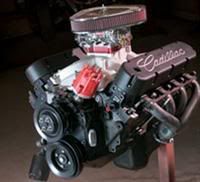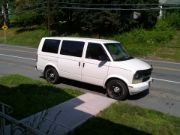Most rodders know the 500-inch Cadillac V-8 was a reliable powerplant in the traditional V-8 mold. Produced from 1970-’76, the big-inch Caddy powered some of the longest and heaviest cars to ever wear the Cadillac crest. These low compression bruisers were never known for their performance, but rather their silky-smooth delivery of seemingly boundless torque.
While the 500 was built from 1970 until 1976, there were few changes from its beginning until its end. The largest and most significant of these changes was the compression ratio. When launched in 1970, the 500 had a stout 10:1 compression ratio, which was good for 400-horsepower and 550 ft.-lbs. of torque right from the factory! That’s pretty impressive, even among the rest of the muscle car engines offered in ’70. But, like the rest of the great Detroit V-8s, 1970 was the pinnacle year. In 1971, compression dropped to 8.5:1 and power dropped with it.
In today’s age of big-inch, low compression hot rod crate engines, it seems the 500 Caddy (and its marginally smaller companion, the 472) were ahead of their time. The Chevy 502 is a great example. Now offered through any GM dealer, the 502/502 can be had for around $10,000 (PN 12496962) and deliver 502 peak horses and 567 ft.-lbs. It’s a very popular choice among street machine enthusiasts, and thousands are seeing duty across the country.
What we set out to do was meet the torque numbers the big Chevy is delivering for about half the cash outlay. We’re not out to beat the horsepower number on this build because this engine will have no need to spin higher than 4,000 rpm. If we wanted to focus on higher rpm performance and peak horsepower numbers, we know the Caddy could respond, but we wanted a reliable performer to pull a heavy mid-’50s Packard down the freeway in overdrive. For this purpose, high horsepower won’t be necessary, but big torque in the lower rpm ranges will be critical. The 500 Cadillac is perfectly suited for such duty.
One of the most appealing things about the 500 Caddy is its low buy-in price. These engines are readily available as rebuildable, complete cores for a couple hundred bucks (or less) nationwide. They’re simply not hard to find or afford, and this cannot be said about many 500-inch engines. Once acquired, there are precious few modifications required to ensure a solid long-term performance engine. With all this going for it, why has the Cadillac not become even more popular?
We feel it has to do with compatibility. The Cadillac bolt pattern is one that was shared with Buick, Oldsmobile, and Pontiac throughout the ’60s and ’70s, and is commonly known as the B/O/P bellhousing pattern. Modern overdrive transmissions typically have Chevy bolt patterns, with the exception of the 200-4R built in the ’80s. Also, engine mounts and exhaust routing will have to be Cadillac-specific, but we’ve learned these potential roadblocks are also being lessened with help from the aftermarket. The engine’s overall external dimensions are similar to other big-blocks of the era, so this should not scare anyone away either.
After researching the Cadillac and finding a bustling aftermarket anxious to assist us, we have to say there is no good reason not to build a Caddy anymore. What few issues there are with the design have been addressed, and the low buy-in makes it a relative steal when the final power figures are in. Watch as we build a 500-incher from the ground up and then fine-tune it on the dyno. The homework paid off, as you’ll soon see!
Our 500 is from ’74, and also carries the dismal 8.5:1 compression ratio. We immediately remedied the problem with some forged Ross pistons. In addition to boosting our compression ratio up to 9.6:1, they are designed with a dish, which reflects the shape of the combustion chamber. This means there is still a good quench area between the piston top and the flat bottom surface of the cylinder head outside the combustion chamber. Quench areas like this serve several purposes, but forcing the air/fuel mixture into the combustion chamber is chief among them. By controlling where the air/fuel mixture burns, more efficiency is gained. This results in more horsepower, torque, and fuel economy along with reduced emissions. We’re simply burning the air/fuel mixture more effectively.
Follow with us as we add some modern technology and research to the classic big daddy Caddy. The results might have you looking at this powerplant differently. For those budget-conscious rodders among us, know this fact: we’ve never seen so much torque built for so few bucks! Enjoy!
Well it's alittle much for me to tackle,but maybe some of our young bucks or oldtime other hot rodders might want to consider one for their Astro van and make it work.Sure beats the costs of a BBC 502 with similar torque results.
A Astrolac-





